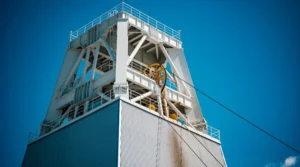Within two years, PGNiG will increase its natural gas and crude oil production by 13% and 12%, respectively. The Company expects that in 2021 it will produce 5.2 bcm of natural gas and approximately 1.4 million tonnes of crude oil both in Poland and abroad.
Polskie Górnictwo Naftowe i Gazownictwo has announced its hydrocarbon production forecast for 2019–2021. Production of natural gas from fields located in Poland and abroad will amount to 4.6 bcm in 2019, 4.8 bcm in 2020 and 5.2 bcm in 2021. Crude oil production volumes will reach 1.3 million tonnes in 2019 and 1.4 million tonnes in 2020 and 2021.
‘We consistently focus on developing our own production capacities in Poland and abroad. Exploration and Production is the most profitable segment of the PGNiG Group’s business. In addition, development of our own gas reserves helps improve the country’s energy security,’ said Piotr Woźniak, PGNiG SA’s CEO.
Poland
Natural gas production from Polish assets will increase from 3.9 bcm in 2019 and 2020 to 4.0 bcm in 2021. Production will increase as new wells in the Podkarpacie region and Polish Lowlands are brought on stream. Since 2016, PGNiG has been engaged in large-scale exploration projects in these regions, which have helped reverse a long-lasting downward trend in natural gas production in Poland.
In 2019 the volume of crude oil production in Poland will reach 778 thousand tonnes, while in 2020 and 2021 it will go down to 747 thousand tonnes and 733 thousand tonnes, respectively. The decline will result from natural depletion of domestic deposits.
Norway
According to the forecast, natural gas output from the Norwegian Continental Shelf will be 0.5 bcm in 2019 and 2020, and will increase to 0.7 bcm in 2021. Crude oil production (including condensate and NGL) will amount to 475 thousand tonnes in 2019, 611 thousand tonnes in 2020 and 671 thousand tonnes in 2021.
At the same time, the Company is engaged in efforts to acquire new production assets that would allow it after 2022 to supply gas (including 2.5 bcm from the Company’s own production) via the Baltic Pipe with an annual capacity of 10 bcm. According to the Norwegian authorities, less than a half of Norway’s estimated oil and gas reserves have been produced since the early 1970s.
‘In Norway, we focus on optimising production from our existing fields and on accelerating projects to develop new ones,’ said Piotr Woźniak and added ’Each investment is carefully thought-out. We select only those assets which promise to be economically viable, with solid rates of return, and are bound to markedly increase the Group’s production on the Norwegian Continental Shelf’.
In 2019, the subsidiary PGNiG Upstream Norway made two major acquisitions: it purchased a 20% interest in the Duva field within the PL636 and PL636B licence areas and a 22.2% interest in the King Lear field in the North Sea within the PL146 and PL333 licence areas.
At present, the Company is producing from five fields: Skarv, Gina Krog, Morvin, Vilje and Vale, while field development projects are being carried out in five more, namely: Skogul, Ærfugl, Duva, Tommeliten Alpha and King Lear.
Launch of production from the Skogul field is scheduled for the end of 2019 and beginning of 2020, while the Ærfugl and Duva fields are to come on stream in late 2020 and early 2021.
Production from the Tommeliten Alpha and King Lear fields is expected to commence in 2024 and 2025, respectively. After obtaining the Norwegian administration consents to buy the Duva and King Lear fields, the Company will hold 27 licences in Norway, currently acting as the operator under four of them.
Pakistan
PGNiG expects to step up its natural gas production in Pakistan to 0.4 bcm in 2020 and 0.5 bcm in 2021, up approx. 100% and 150%, respectively, on 2019, when the Company’s target production is to reach 0.2 bcm. Such substantial growth will be possible with the bringing on stream of new wells. At present, eight PGNiG’s wells are connected to the gas transmission system in Pakistan. By the end of the year, the Company will complete drilling and start testing two new wells and will start drilling two more.
PGNiG








